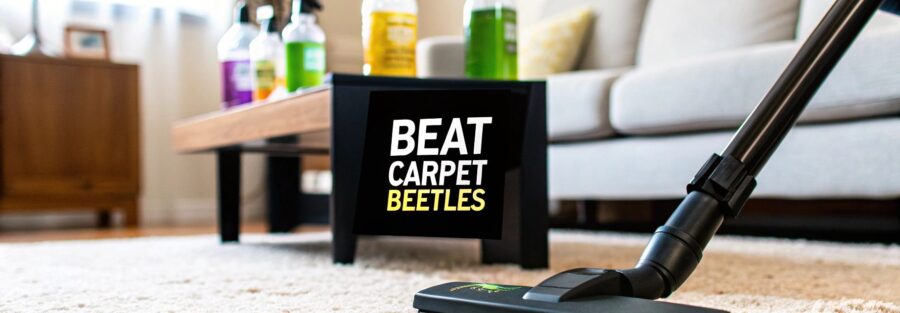Before you can even think about treating carpet beetles, you need to be absolutely certain they're the ones causing the trouble. Spotting a couple of small adult beetles near a window is pretty common and doesn't necessarily mean you have a full-blown infestation.
The real proof lies in the subtle, destructive clues left behind by their larvae, often called 'woolly bears'.
How to Spot a Carpet Beetle Infestation
The most obvious sign is the damage they do to natural fabrics. But unlike the neat, clean holes left by clothes moths, carpet beetle larvae create more of a messy, scattered pattern.
You might notice things like:
- Bald patches on your woollen rugs where the pile has been chewed away right at the base.
- Areas on upholstered furniture that look thin, almost as if the fabric is just wearing out unevenly.
- Random, jagged holes in a favourite cashmere jumper you've had tucked away in a drawer.
Finding the Hidden Evidence
These larvae are masters of disguise. They love dark, undisturbed spots where dust, fluff, and pet hair gather – it's a buffet for them. To find the source, you'll need to do a bit of detective work in your own home.
Get down on your hands and knees and check along skirting boards, pull out heavy furniture like sofas and bookcases, and have a good rummage in the deep corners of your wardrobes.
This is where to focus your search, highlighting the most common hiding spots for these pests.

As you can see, infestations often kick off in low-traffic areas before they start to spread, which is why a thorough inspection is so important.
What you're looking for are tiny, hairy, caterpillar-like larvae and their discarded, bristly skins. These shed skins look like see-through, empty shells of the larvae and are a dead giveaway of an active problem.
Carpet beetles are a major pest in UK homes. A single female can lay 40 to 100 eggs that hatch within just two weeks. It’s these hungry larvae that go to town on your wool, silk, leather, and fur, surviving for months and causing a huge amount of damage if you don't step in.
Carpet Beetle vs Clothes Moth A Quick Identification Guide
It's easy to mistake carpet beetle damage for that of the common clothes moth, as both target natural fibres. Getting the culprit right is crucial for effective treatment. Here’s a quick comparison to help you tell the difference.
| Characteristic | Carpet Beetle Larvae ('Woolly Bears') | Clothes Moth Larvae |
|---|---|---|
| Appearance | Hairy or bristly, often striped (brown/tan). Short and stout, about 4-5mm long. | Creamy-white, caterpillar-like with a dark head. Smooth body, no bristles. |
| Movement | Crawls freely and openly on surfaces. | Hides in silk webbing or tubes it spins on the fabric it's eating. |
| Damage Pattern | Creates large, irregular holes or eats the surface nap of fabrics (e.g., bald patches on rugs). | Leaves smaller, more defined, and often numerous small holes. |
| Evidence Left | Shed, bristly skins and tiny faecal pellets (like sand). | Silken webbing, tunnels, or cocoons left on the fabric surface. |
Knowing these differences will point you in the right direction. While both are unwelcome, their habits are distinct, which means your approach to getting rid of them needs to be too.
Key Takeaway: Don’t just look for the adult beetles. Finding larvae or their shed skins in dark, quiet corners is the most reliable sign you have a carpet beetle problem that needs dealing with, and fast.
Distinguishing them from other household pests is also vital. If you’re not sure if you’re dealing with beetles or something else, our guide on how to identify flying insects in the UK can help. A correct ID from the start means your efforts will be targeted and far more effective.
Your First Action Plan: Deep Cleaning and Decluttering
Right, so you’ve found carpet beetles. The first move is a full-on, methodical clean-out. This isn't your usual weekly hoover; think of it as a strategic mission to get rid of larvae, eggs, and whatever they’re feeding on, from every nook and cranny. Acting fast and being thorough at this stage is the bedrock of getting rid of them for good.
Before you dive in, it helps to know exactly what you’re getting into. For a full rundown on what this level of cleaning looks like, understanding what deep cleaning entails can give you a better game plan for evicting these pests.
The Power of a Systematic Vacuum
Your vacuum cleaner is your best friend here. Start by methodically going over all carpets, rugs, and upholstered furniture. Don't just give it a quick once-over. You need to pass over each section multiple times and from different directions to really shake up the fibres and suck out any hidden larvae and eggs.
The real work, though, happens with the attachments. The crevice tool is absolutely essential for this job. Use it to meticulously get into all the gaps along skirting boards, the edges where carpets meet walls, and deep down the sides of sofa cushions. You also need to shift the heavy furniture – bookcases, beds, the lot – and hoover properly underneath. These undisturbed, dusty spots are prime real estate for carpet beetle larvae.
And this is crucial: after every single cleaning session, take the vacuum outside and empty the bag or canister directly into a sealed bin bag. If you don't, you're just giving any live ones you've caught a chance to crawl straight back out.
Heat Treatment for Infested Items
High temperatures are lethal to carpet beetle larvae and eggs. They just can't handle it. You can easily use this to your advantage when you're dealing with infested fabrics.
Gather up any washable items that might be home to them, things like:
- Clothing (especially anything made of wool, silk, or other natural fibres)
- Cushion covers and throws
- Curtains and fabric blinds
- Small rugs and bath mats
Chuck everything in the wash on the hottest setting the fabric can take, ideally 60°C or higher. If you have delicate items that can’t handle a hot wash, a trip to the dry cleaners is a solid alternative – the chemicals they use will finish the job. For items you can’t wash at all, sealing them in a black bag and leaving it in direct sun on a hot day can often generate enough heat to kill them off.
Expert Tip: Don't forget your wardrobes and drawers. Once you've emptied them for washing, give the inside of every single one a thorough vacuum. Pay extra attention to the corners and joints where larvae love to hide out.
Declutter to Remove Hiding Spots
Clutter is a carpet beetle's best friend. It gives them all the dark, undisturbed hiding places they need to thrive. Piles of old magazines, forgotten boxes under the bed, or a wardrobe crammed with clothes you never wear are all perfect breeding grounds.
Go through your home one room at a time and be ruthless. Get rid of anything you don’t need anymore, especially if it’s made from natural materials and has been sitting there for ages. Organising your stuff doesn't just get rid of their habitats; it also makes your regular cleaning far more effective, which seriously cuts down the chances of them ever coming back. When you combine a deep clean with a proper declutter, you're hitting them where it hurts and taking back your space.
Choosing the Right Pest Control Products

After a deep clean, the next move in your battle against carpet beetles is often a targeted treatment to catch any stragglers. Staring at the pest control aisle can be overwhelming, with dozens of sprays, powders, and traps all promising to solve your problem. The key is knowing what you're looking at and choosing the right tool for the job.
Your options generally fall into two categories: chemical insecticides and natural, eco-friendly alternatives. One isn’t automatically better than the other; the right choice really depends on how bad the infestation is and your personal situation, especially if you have children or pets running around.
Understanding Chemical Insecticides
Chemical treatments are often the go-to for a reason—they're incredibly effective. You'll typically find two main types. Contact sprays are for the ones you can see, offering an immediate knockdown of larvae and adult beetles on sight. They're great for a quick fix, but their effects don't last.
For longer-term control, you need a residual insecticide. When sprayed into cracks, along skirting boards, and in other hidden spots, these products leave behind an active ingredient that keeps working for weeks. This is absolutely vital for breaking the carpet beetle life cycle, as it catches new larvae that hatch after your initial blitz. Remember to apply these in the hidden areas where larvae feed, not all over open floors where they're less likely to be.
Interestingly, in the UK, carpet beetle larvae are now a more common textile pest than clothes moths. These larvae, which grow up to 4 mm long, are the ones doing all the damage, feasting on fluff and fibres in undisturbed places like under carpets and between floorboards. You can get the full rundown on their habits from the British Pest Control Association's guide.
Safer Alternatives for Your Home
If you'd rather steer clear of strong chemicals, there are some brilliant natural options that still pack a punch. These products work physically, not chemically, which makes them a much safer choice for many homes. We cover these methods in more detail in our guide to eco-friendly pest control.
Here are two of the most reliable choices:
- Diatomaceous Earth (DE): This is a fine, talc-like powder made from fossilised algae. Under a microscope, it's all sharp edges. These scratch the waxy outer layer of an insect's exoskeleton, causing it to dehydrate and die. Just a light dusting in affected areas is all you need.
- Boric Acid: A naturally occurring compound that’s lethal to beetles when they eat it. It’s usually applied as a powder, but you can also mix it with water to create a spray for getting into tight cracks and crevices.
Important Safety Note: Just because these products are 'natural' doesn't mean you can be careless. Always wear a mask when applying fine powders to avoid breathing them in, and keep pets and children away from treated areas until you’ve had a chance to vacuum up any excess. With the right product and careful application, you're well on your way to a beetle-free home.
Building a Beetle-Proof Home Environment

So you've dealt with the active infestation. That's a huge step, but the job isn't quite finished. Treating carpet beetles is only half the battle; the real victory is making sure they never feel welcome in your home again. This means creating an environment where they simply can't find the food or tiny gaps they need to get re-established.
The trick is to start thinking like a beetle. Adult beetles fly in from the outdoors, searching for a safe, quiet place to lay their eggs. The larvae that hatch then need a steady supply of natural fibres to survive. If you can cut off both of these, you build a powerful defence.
Securing Your Valuables
Proper storage is absolutely non-negotiable, especially for things you only pull out once a year. Carpet beetle larvae adore wool, silk, fur, and leather, which makes your off-season wardrobe a prime target.
Don't just push your winter jumpers to the back of the wardrobe and hope for the best. You need to invest in proper, protective storage.
- Airtight Containers: Get some good-quality plastic tubs with secure locking lids. These are perfect for folded items like woollen blankets, scarves, and cashmere jumpers. They create a barrier that's simply impenetrable.
- Garment Bags: For hanging items like wool suits or coats, choose breathable cotton or sturdy vinyl garment bags. Leaving them exposed on the rail is just asking for trouble.
Here’s a crucial tip: before you store anything, make sure it's professionally cleaned. Larvae are drawn to microscopic food stains and human sweat, so a clean item is a much less attractive meal.
Your wardrobe isn't just for clothes; it's a potential buffet for pests. Sealing off-season natural fibres in airtight containers is one of the single most effective steps you can take to prevent a future infestation.
Strengthening Your Home's Defences
Adult carpet beetles don't just magically appear inside your home—they have to get in from somewhere. A careful walk around the outside of your property can reveal dozens of potential entry points that you can easily seal up.
Start by doing a slow lap of your house. Look for tiny cracks in the foundation or small gaps around window frames and door frames. A bit of quality caulk or sealant is all you need to close these openings for good. Also, pay close attention to where utility pipes or wires enter the property and fill any gaps you find.
Beyond sealing cracks, think about beefing up the defences at obvious entry points like windows and doors. This includes checking that they seal properly when closed and considering installing insect screens to add another solid layer of protection.
Don't forget to check the screens you already have for any rips or tears and get them repaired promptly. It’s these small, proactive fixes that make the biggest difference in keeping pests out for good.
When You Should Call in the Professionals
Let’s be honest, tackling a small carpet beetle problem with a good vacuum and some elbow grease often does the trick, especially if you catch it early. But there are times when, despite your best efforts, the little blighters just keep coming back. Sometimes the problem is just too widespread for DIY methods to be truly effective.
Knowing when to wave the white flag and call in an expert is crucial for protecting your home from serious, long-term damage.
The Tell-Tale Signs a DIY Approach Isn't Cutting It
The clearest sign you're out of your depth is the sheer scale of the issue. If you've found larvae in multiple rooms—not just one forgotten corner of a wardrobe, but also under the living room sofa and along the bedroom skirting boards—it’s a strong signal the infestation is well-established. At that point, trying to track down every last hiding spot becomes an almost impossible task for a homeowner.
A problem that keeps returning is another massive red flag. You’ve done everything right: deep-cleaned, washed every textile in sight, and applied treatments, only to find fresh signs of larvae a few weeks later. This frustrating cycle usually means you've missed the main breeding ground, which could be tucked away in a wall void, under floorboards, or deep within loft insulation.
Here are a few situations where calling an expert is your best move:
- You Can't Find the Source: Professionals are trained to think like pests. They know all the obscure places to look for hidden nests that you’d likely never find on your own.
- The Infestation Is Widespread: If you're spotting signs in several unconnected areas, a pro can implement a coordinated, house-wide treatment plan that actually works.
- You Have High-Value Items at Risk: If you own expensive wool rugs, antique furniture, or a taxidermy collection, the risk of irreversible damage from guesswork is just too high.
A professional pest controller does more than just spray insecticide. They carry out a proper investigation to diagnose the root cause of the infestation, ensuring the treatment is targeted and, most importantly, effective.
What to Expect from a Professional Service
When you hire a professional, the first thing they'll do is a detailed inspection. They need to identify the exact species and map out the extent of the infestation. Based on what they find, they’ll put together a treatment plan.
This often involves using commercial-grade insecticides that are far more potent and have a longer residual effect than anything you can buy over the counter.
They might also bring in specialised equipment. For stubborn textile pests, professionals often rely on methods like professional heat treatment, which can wipe out pests at every life stage without using chemicals. It’s a fantastic option for delicate items or particularly severe infestations where you need a guaranteed kill. If you want to know more about this, we have a whole guide on how professional heat treatment gets rid of textile pests.
As for cost, professional services in the UK can vary. A multi-visit treatment plan might start from around £150 plus VAT. The price reflects the need for follow-up visits to break the entire life cycle and ensure the problem is gone for good. Investing in an expert not only solves the immediate issue but gives you the peace of mind that the job has been done thoroughly.
Still Have Questions About Carpet Beetles?
Even when you know what to do, it's natural to have a few lingering questions. When you're tackling an infestation, you want to be sure you're doing everything right. Let's clear up some of the most common queries we get from clients.
How Long Does It Actually Take to Get Rid of Them?
This is the big one, and the honest answer is: it depends. The timeline for getting rid of carpet beetles completely hinges on how widespread the problem is and how quickly you caught on.
If you’ve only found a handful of larvae under a single rug, you might be in the clear within a week or two. That usually just requires some really thorough, targeted cleaning in that one spot.
A more established infestation, however, is a different beast entirely. If they've had time to spread into multiple rooms, you’re looking at a longer battle—think several weeks, or even a couple of months. Your goal isn't just killing the larvae you can see; it's about breaking their entire life cycle. That means staying on top of things to catch any new larvae that hatch from eggs you might have missed.
A one-off deep clean won't solve a widespread issue. Consistency is your best weapon here. Regular vacuuming and keeping a close eye on things are vital to stop them from bouncing back.
Are Carpet Beetles Actually Harmful?
This is a worry for a lot of people, especially if there are children or pets in the house. The good news? Adult carpet beetles don’t bite or sting. They pose no direct threat to you or your family.
The real nuisance comes from the larvae. Their bodies are covered in bristly, coarse hairs which they shed as they grow. For some people, coming into contact with these tiny hairs can trigger an allergic reaction. This usually looks like an itchy, red rash, and it’s often mistaken for bites from other pests like fleas or bed bugs. It even has a name: carpet beetle dermatitis.
While the rash is unpleasant, the real damage these pests do is to your home. Their appetite for natural fibres can ruin expensive carpets, heirloom clothes, and treasured furniture, which is why dealing with them quickly is so important.
Can Carpet Beetles Get Into My Bed?
Yes, unfortunately, they can. While it’s not their number one spot, finding carpet beetle larvae in your bed is definitely possible, especially if your bedding contains the natural fibres they love to eat.
What makes a bed attractive to them?
- Woollen blankets or underlays: This is a five-star meal for a carpet beetle larva.
- Feather or down duvets and pillows: The feathers are another prime food source.
- General debris: They're not fussy. Hair, dead skin cells, and other bits of organic matter that naturally build up around a bed can also keep them going.
If you find any evidence of them in your bed, you need to act fast. Strip all the bedding and wash it on the hottest setting the fabric can take. Then, get the vacuum out. Use a crevice tool to go over every inch of the mattress—paying close attention to the seams and tufts—the bed frame, the headboard, and the entire floor area underneath.
At Pest Predators Limited, we know how stressful a persistent infestation can be. If you've tried everything and they just keep coming back, our expert team is here to help with professional, proven solutions. Contact us today for a consultation and get your peace of mind back.



